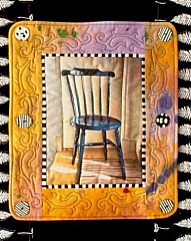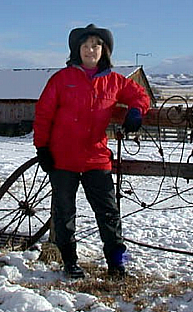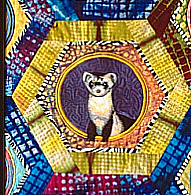In the Folk Center
Winter in the Center

Adios Amigos:
Hola Mexico!
detail from
Swedish Design Sampler #3
Copyright Ó 2006. Dancing Bear Folk Center




Trapping in the
Big Horn Basin
Home on the Range
Early Wyoming Photos
Glade Edwards Collection
Expanded Quilt Block Wall
New Marbles
in the Collection
1870s Shipwreck Marbles
Mazet Family Marbles,
Ten Sleep, Wyo.


Exhibit: "Putting By"
A History of Canning:
Fruit Jar Collection
* Dancing Bear Quilt by:
Judy Zehner & Kim Mosher, Quilted Legends,
Steamboat Springs, Colorado
*
Other Links of Interest
Natural Resources & Wildlife
The Quilting Cowgirl
Marta Amundson
Marta Amundson is a professional quiltmaker and fiber artist who has taught and exhibited her work around the world. In 2001, she won the prestigious American Folk Art Museum (New York) International Spirit of Design Competition.
Marta and her husband, Larry, live on the Lazy Eight Two ranch near Ocean Lake outside of Riverton, Wyoming, which she describes as "seven cattle guards from civilization."
She grew up in 36 different places in the US and Europe. "Even as a very young child, I wanted to be a cowgirl," she writes. "I aspired to the raw courage, independence and stubborn daring required to follow my dreams. You don't really need a horse or lariat to be a cowgirl, only a strong will, an obstinate streak, self-reliance and skill."
She earned a Bachelor of Arts degree in visual art and art history from Albion College, Michigan, and an associate degree of science from Central Wyoming College. Marta spent a semester at the University of Stockholm and apprenticed in the photo studio of the Metropolitan Museum of Art. She moved to Wyoming in 1975 after meeting her future husband Larry. They have been married for 29 years; and in that time, Marta realized her dream of becoming a cowgirl.
Marta became interested in the fiber arts as a child and learned to quilt from her grandmother. A friend in Sweden taught her to weave in addition to the needle arts that she learned as an exchange student there.
Marta was chosen for two Wyoming Arts Council artist fellowships in 1995 and 2002. Her work is included in several permanent collections, including Wyoming State Museum and the Rocky Mountain Quilt Museum.
On a Purpose to Art…
Marta uses her ability to create art to make bold statements. Women's issues, world politics, her dreams, the environment - anything she cares about - can become a springboard to creativity. She does not leave the viewer guessing as to what she means. "On the back of each quilt, I write a statement on fabric," she says. "This gives me the opportunity to share my voice with the public and reinforce that voice with a visual image that they can remember. My goal is not to change anyone's point of view but rather to distinctly express my own."
Marta is an avid outdoors enthusiast. Skiing, fly fishing and kayaking are just a few of her hobbies. This interest in the natural world led her to create quilts featuring wildlife - everything from dolphins to cranes to prairie dogs. "You can't live in a place like Wyoming and ignore the environment," she wrote in the introduction to her quilt pattern book, Quilted Animals (American Quilters Society, 2002). "Some people may not care about what happens to a rare species of fish or a little bird… or if wolves are again a part of the Yellowstone ecosystem. However, I really do care."
On Travel as Inspiration…
Marta travels extensively. In addition to teaching in the Unite States, she has taught quilting workshops in Europe, the United Kingdom, Australia and Brazil. Marta has also traveled to exotic places to view and photograph endangered animals for the drawings on her quilts. "My inspiration can come from an early morning in the rain forest canopy of Puerto Rico, a camel saddle in Egypt or looking for Bengal Tigers and One-horned Rhinos from the back of an elephant in Nepal."
The year of her 40th birthday, she wrote, "I started to worry about my life being half over." She and a girlfriend set off to see the Sphinx in Egypt. "We sailed down the Nile and rode camels in the desert. We rode donkeys into the Valley of the Kings at sunrise and saw the tomb of King Tut. I cried when 17 tourists were murdered by the Islamic jihad on the steps of the hotel where we had slept three nights before. We carefully avoided all the men with assault rifles but made friends with the children in the streets. It was a wonderful journey."
On Art for Children…
Marta finds that quilt-making is an exciting and valuable activity for elementary school children. "Quiltmaking is noncompetitive, and every child participates equally," she says. Exposing children to art expression at an early age is critical. "Elementary-aged children are eager to try new things. They learn to make things with their hands in order to build self-esteem. It is important for children to make things with their hands, to see connections between the subjects and ideas they encounter in school," she explains "They need to know that what they learn has practical application in the world. I like to show kids that quilt-making uses many of the skills they learn in the classroom, and that there really is a good reason to learn subjects like math and how to multiply." She frequently teaches as an Artist in Residence in Wyoming schools through the Wyoming Art in Education program.
Contact Info...
Marta Amundson: [email protected]

Marta Amundson
Outside of her ranch in
Riverton, Wyoming















